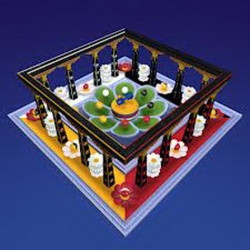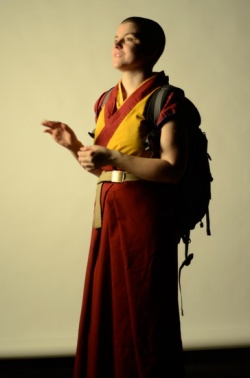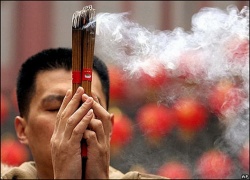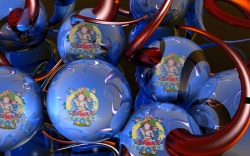Shubhakarasimha
Shubhakarasimha 善無畏 (Skt; Jpn Zemmui)An Indian monk who first introduced Esoteric Buddhism to China and became known in China as Shanwuwei.
Śubhakarasiṃha (637-735 CE) (traditional Chinese: 善無畏; pinyin: Shànwúwèi; Japanese: Zenmui; Korean: 선무외, Seonmuoe; Vietnamese:
Thiện Vô Uý) was an eminent Indian Buddhist monk and master of Esoteric Buddhism, who arrived in the Chinese capital Chang'an (now Xi'an) in 716 CE and translated the Mahāvairocana Abhisaṃbodhi Tantra, better known as the Mahāvairocana Sūtra.
Four years later another master, Vajrabodhi (670-741 CE), and his pupil Amoghavajra (705-775 CE), would arrive and proceeded to translate other scriptures, thus establishing a second esoteric tradition.
Along with these other masters, Śubhakarasiṃha was responsible for bringing Esoteric Buddhism to the height of its popularity in China.
Life in India
According to his biography, Śubhakarasiṃha was born as the son of royalty in a northeast Indian kingdom, and ascended to the throne as king when he was thirteen years old.
Although emerging victorious from a power struggle with his older brothers, he turned over his position to his oldest brother and entered the monastic life.
He became well known for his supernatural abilities, and finally settled in Nālandā where he met the master Dharmagupta.
After being instructed by him, Śubhakarasiṃha became a traveling teacher, and was then told by Dharmagupta to go further east to China.
Life in China
When Śubhakarasiṃha arrived in China, he was already eighty years old.
Upon his arrival, he became well known for his supernatural abilities, and became favored by Emperor Xuanzong of the Tang Dynasty.
It was during this time that he translated several works of Esoteric Buddhism including the Mahāvairocana Abhisaṃbodhi Tantra.
With Yixing
According to Robert Sharf, Chán Master Yi Xing (Ch. 一行禅師) was the most eminent of his students. Yixing belonged to the northern school of Chán Buddhism,
but this was not seen by Chinese Buddhist culture as being fundamentally different from the esoteric teachings of Śubhakarasiṃha. Around the turn of the eighth century, the northern school was known for its esoteric practices of dhāraṇīs and mantras.
In Shingon Buddhism
Śubhakarasiṃha was the first patriarch of the Shingon teachings in China. Following Śubhakarasiṃha, the lineage is traced to his student Chán Master Yixing, then to Huiguo (Ch. 惠果), and finally to Kūkai (Jp. 空海), who brought the teachings of Śubhakarasiṃha and his translation of the Mahāvairocana Abhisaṃbodhi Tantra to Japan.
See; Shanwuwei.



